ASRock X370 Killer SLI/ac Motherboard Review
Why you can trust Tom's Hardware
Benchmark Results
Synthetics
The Killer SLI/ac gets hit right off the bat with some unfortunate PCMark losses, lagging behind the pack by a whopping six percentage points (from the leader). However, the remainder of the Sandra synthetics are showing much closer comparisons across the samples, with the Killer winning memory bandwidth, crypto, and arithmetic workloads.





Unfortunately, the Compubench FaceDetect workload shows atypical results compared to my previous samples. Our data does line up with Compubench’s aggregate average for the GTX 970, so retests are needed to confirm repeatability. Performing a fresh install of the operating system and updating Windows and drivers to appropriate levels still shows repeatable Compubench outcomes. It would be interesting to compare some of the previous hardware with the latest Windows updates to confirm whether driver updates are the culprit.


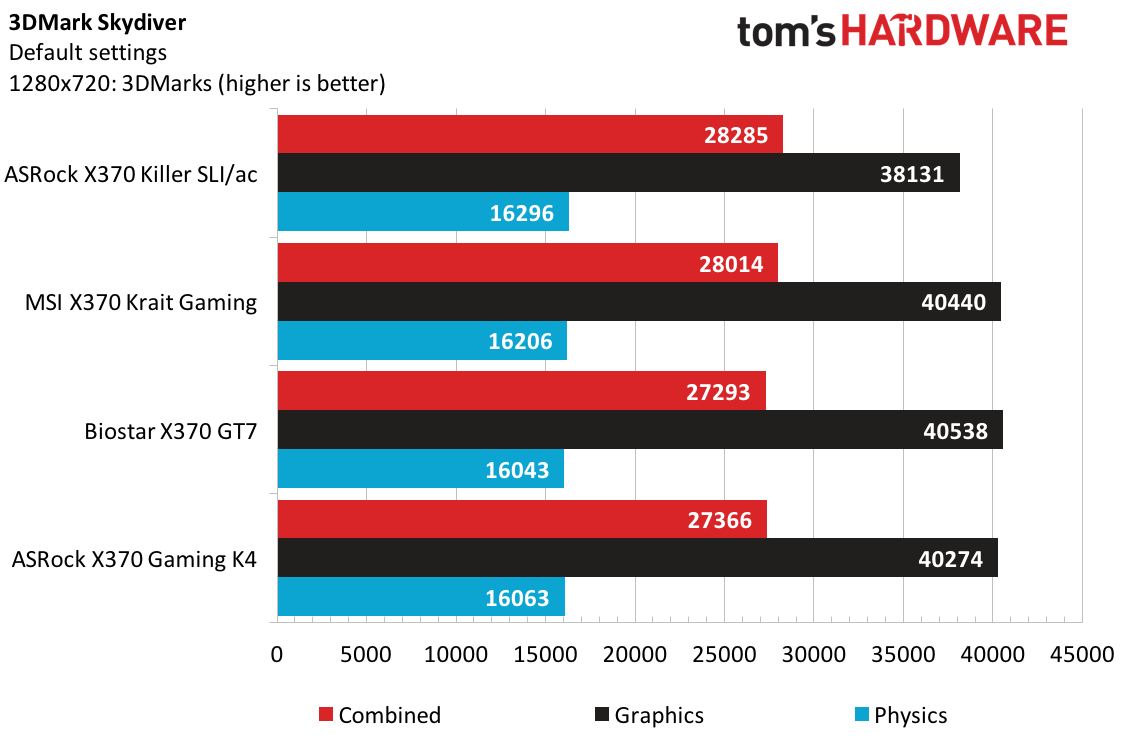

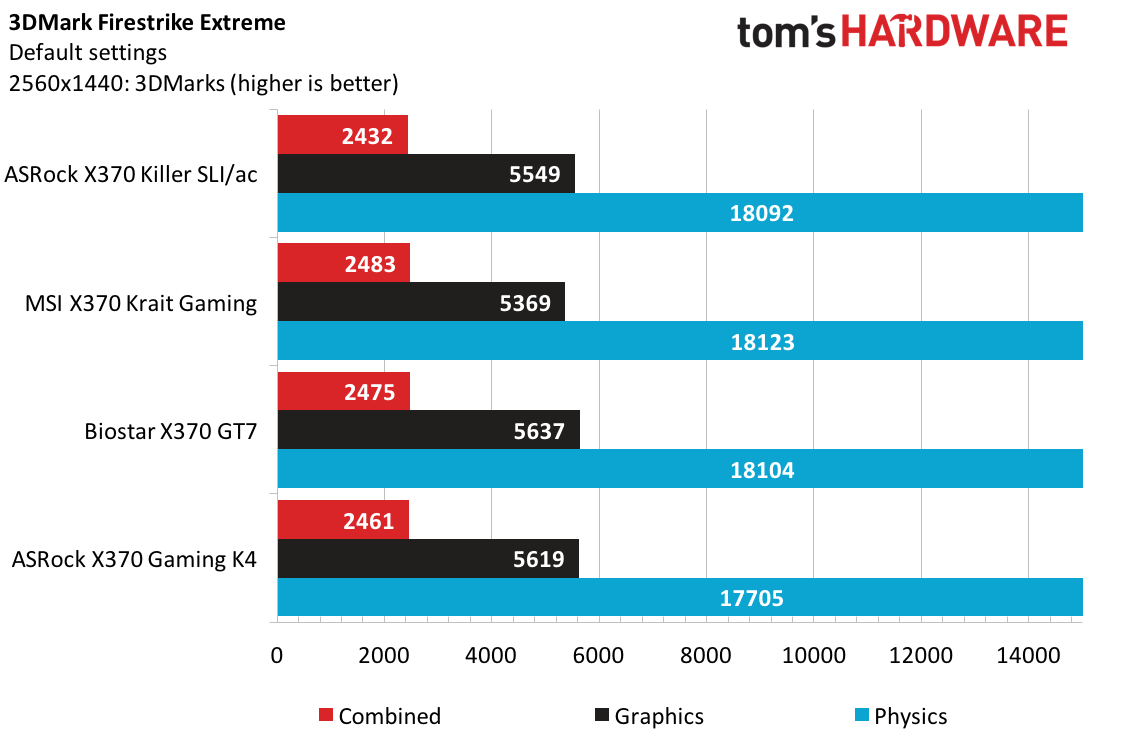
This trend continues in the 3DMark suite, where the combined scores are comparable to other review samples, but graphic scores trail by up to five percentage points within the Skydiver benchmark. Cranking up to Firestrike Extreme evens the playing field and helps shift the focus from the board and processor to the graphics card alone.
Timed Applications
The application data was less than interesting from our perspective, showing a very narrow delta across samples such that any explanation would likely be in the margin of error. The only application of note is in 7-Zip, where the Killer SLI/ac finishes the job eight seconds before our previous leader and laughs on the sideline as its brother, the ASRock X370 Gaming K4, huffs and puffs across the finish line 43 seconds later.


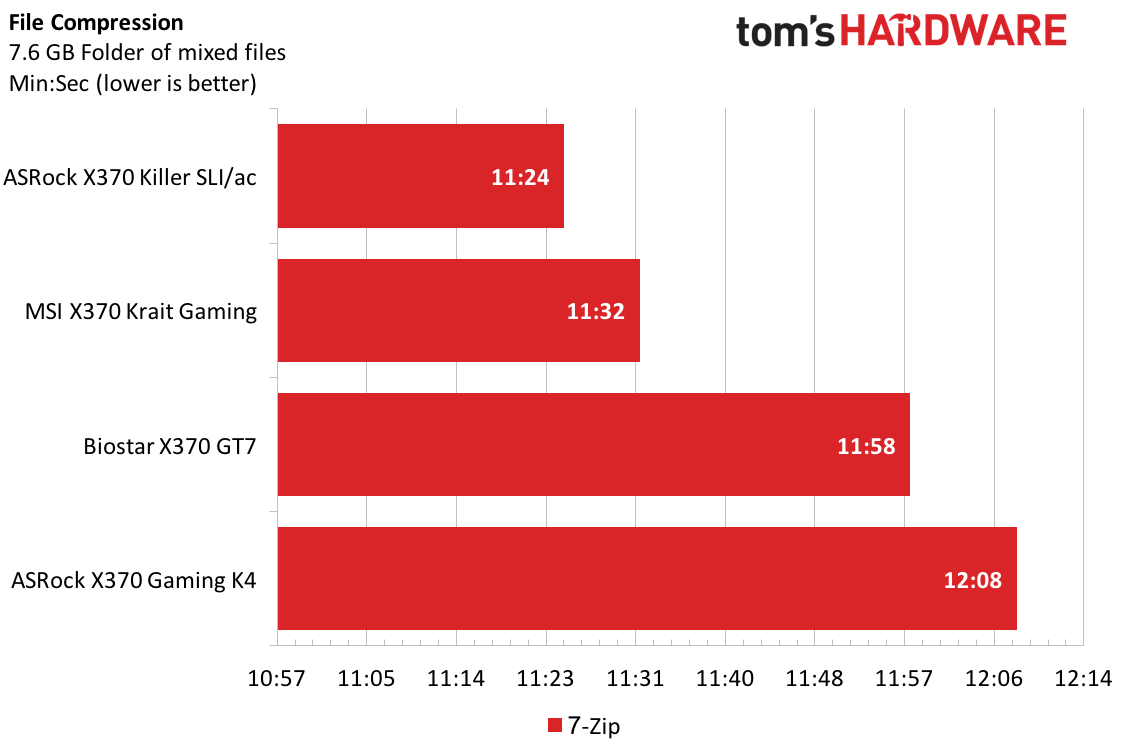
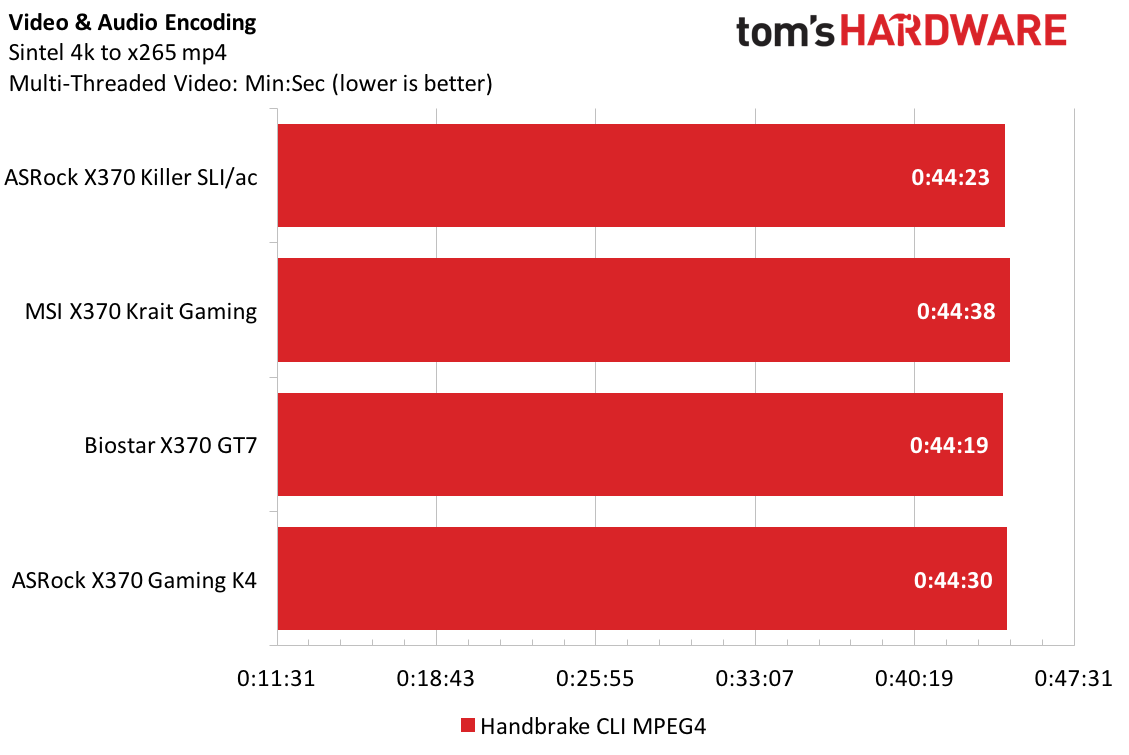
Overall, a mixed success for the ASRock X370 Killer SLI/ac is only compounded by driver issues in the graphics department. Hopefully, this is only evident in the synthetics portion and the games will show the true story.
3D Games
To reiterate, the ASRock X370 Killer SLI/ac ushers in the era of true 4K gaming in my test suite, so any old 3460x1920 data represented here will clearly favor the products tested in older reviews. However, we will include it here for both academic and comparison purposes to see how this combo fairs against the older 40” triple monitor setup. True 4K data will be denoted with asterisks.




Standard Ashes of the Singularity at 1080p sets the stage for the comparisons today by showing that driver issues observed during the synthetics are no longer an issue. The High setting is still playable at all batch conditions for all systems, and Crazy settings favor the MSI Krait Gaming by nearly two frames when compared to the Killer SLI/ac. Increasing the resolution to true 4K on the Killer shows acceptable framerates across all batch conditions with high settings, and increasing the pixel count by roughly 25% only impacts performance by 10%. Even at Crazy settings, true 4K is still equally as unenjoyable as with the other samples. Note we did collect Escalation data for this sample, and will begin publishing that data in the next review. Also, we collected 1440p data, so sit in anticipation as that comes.
Get Tom's Hardware's best news and in-depth reviews, straight to your inbox.


Yawn. F1 2015 throws the Killer SLI/ac into the middle of the pack at 1080p. We are hit by a jump scare as 4K ultra presets show that the increase in pixels drops performance by 24%, which scales nicely pixel-for-pixel. We would anticipate that this sample would perform right in line with the previous samples at the Nvidia Surround resolution of 3460x1920.




The Talos Principle takes a strange twist from the previous benchmark and shows the ASRock Killer SLI/ac leaping past the competition with a four-percentage point lead compared to the Biostar GT7 at 1080p. Even more interesting is that the increased pixel count actually shows little impact at 4K, empowering similar leads for the Killer SLI/ac. Would 3460x1920 have made the delta even larger, or does this game really just not stress this GPU enough?
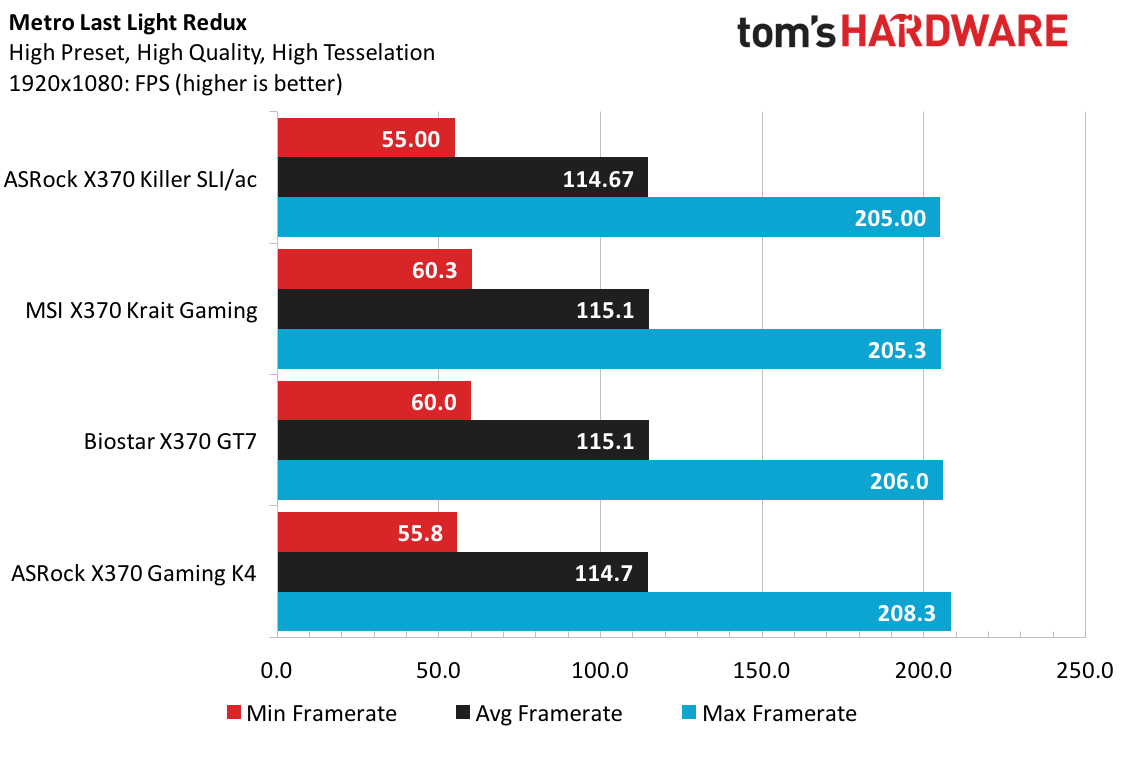



Metro Last Light Redux shows similar trends compared to Ashes in that at 1080p all samples are running neck-and-neck when comparing average framerates. That 4K resolution though. Framerate impact scales fairly well and a 20% performance impact is observed across both detail settings; 4K is only recommended at lower details with the GTX 970.
Gaming on a true 4K monitor with the ASRock X370 Killer SLI/ac feels the same as our previous samples, and the addition of the contiguous monitor real estate is worth the decrease in frames across games. We could perform some statistical manipulation to this data to more directly compare these products with pure numbers, but we think the Killer SLI/ac is still doing well against the benchmarks.
MORE: Best Motherboards
MORE: How To Choose A Motherboard
MORE: All Motherboard Content
Current page: Benchmark Results
Prev Page How We Test Next Page Efficiency, Overclocking & Final Thoughts-
azizisalmane Nice Review, I just wanted to ask you a question, I have the same motherboard, but when i OC my RAM to 2933mhz (which is the max frenquency where windows won't crash) the boot time is like WAY LONGER, (i'm talking about the pre-splash boot, not the windows one), it usually takes like 6 seconds or 7 tops for it to show the asrock logo when on 2134mhz, but once i go up to 2933, the boot time goes up to like 17 seconds. then when it gets to windows it boots up normally within 4 seconds. Have you ever encountered this problem when testing ?! (I also updated the bios but in vain)Reply -
TheTerk Yes, this is likely due to "Advanced Training" options within the UEFI (sorry if that's not the specific name in the menus.) This feature enables the BIOS to do some stability testing on the interface to confirm that it is reliable within the training routine. Each loop of the training can take a few seconds, so your memory interface likely took a few tries to get reliable results.Reply
I'd run a memstress test on your platform to confirm 2933 is stable. -
azizisalmane Thank you So much for your fast answer, well then i guess i'll have to do the memstress test to see if it's stable !! thank you so much again you were a great helpReply -
lightofhonor 2933 is also where I have topped out on the same board. :-/ Trident-Z 3200 16GBx2.Reply -
Wingback18 i have the same board, no complaints . i believe is an awsome price to performance , the black white silver colors mix well with the case and the msi gaming x graphics card .Reply
the R5 1600X Oc well to 3.9 Ghz at 1.3975 V . the ram doesnt go pass 2933 Mhz , maybe one day Ill get those 3200Mhz , or when i get the other two modules .
the rgb is a nice , no too flashie or too much
i do have one question , why asrock put two usb headers on the board. whats the purpose of two ! can someone help me understand that desicion .
ps , two more pwm fan headers would have been perfect ! -
g-unit1111 Asrock's X370 offerings are very solid. I have the Taichi and love it. I almost went with this board, but the extra M2 port on the Taichi made it worth it.Reply -
Malik 722 it's not just the asrock who would put two usb headers on the board many motherboard manufactures put two usb headers on their boards aswell.you can use them to connect additional usb ports to the board and can also connect many other devices.Reply -
Wingback18 @MALIK 722 thanks for the answer, I been thinking . most cases only support thre usb headers , I wonder what elseReply
in the future I would like to one of them m.2 drives -
Malik 722 you see now these days all kinds of devices come equipped with usb interface or connectors and due to that increased connectivity the number of usb ports available on casings and on motherboards is not enough so that is why you see multiple usb headers on boards so that you can increase the number of ports internally and many board manufactures also give extra usb port bay with their expensive boards.Reply